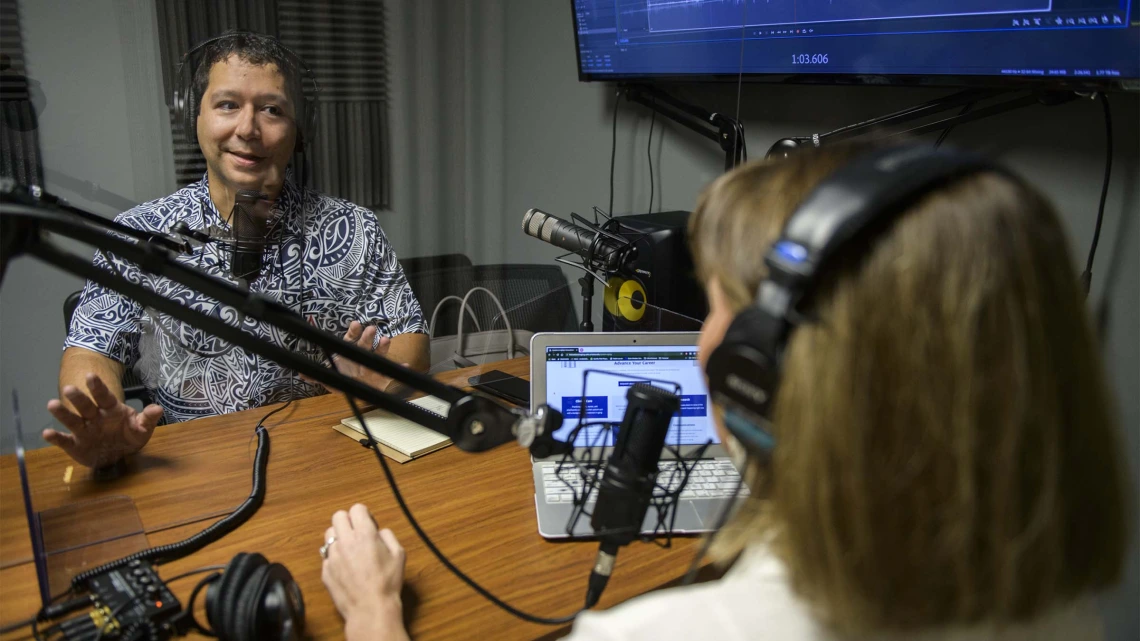Guest Column: Developing Relevant, Accessible Online Education
UArizona Health Sciences International offers new ways to reach, teach and support current and future professionals to serve a growing aging population.

Jon Kevan and Lauren Erdelyi record the Innovations in Aging podcast, a mobile, ascynchronous way for professionals to remain connected to engaging educational information.
Every year the population in the United States gets a little older and a little wiser. By 2030, 1 in 5 adults in the country will be 65 or older. This demographic shift will ignite several changes, from the way we do business and how buildings are constructed, to how health services, policies and legal processes are updated to support and protect older adults.
Tackling these changes and ensuring the workforce has the necessary skills to adapt will require trained professionals to support older adults across a wide array of disciplines. It is no wonder the U.S. Department of Labor and the World Health Organization both consider careers in aging to be high growth areas over the next decade.
To address the global demographic shift, University of Arizona Health Sciences International brought together experts from the Arizona Center on Aging, each of the five colleges at UArizona Health Sciences and across the university. Together, these experts and I worked together to build an interdisciplinary graduate program called Innovations in Aging, which is focused on teaching upcoming and current professionals how to solve problems and leverage opportunities in the field of aging, both in their home communities and around the world.
Engaging and accessible instruction for working adults
While we were building the interdisciplinary Graduate Certificate in Innovations in Aging, one of my goals was to make the progam responsive to the needs of future and current working professionals, which requires the program to meet adult learners where they are and respect their busy schedules. Early in the curricula design process, it became apparent to me that people are constantly bombarded by many things that compete for their time, which can make it difficult to find the motivation to sit down and study after a busy day.
That is why we designed all of the Innovations in Aging courses to be online, asynchronous, applied and based on real world events. Wherever possible, we incorporated opportunities for students to complete assignments and activities by working with people and organizations within their own communities. Fewer “throw-away” assignments and more community engagement means students will leave the program with a greater number of practical skills, as well as the personal connections they need to further their careers.
Digital badges provide motivation along the way
To help keep students motivated, we implemented digital badges that visualize incremental progress, past successes and future goals. Badges provide students with two additional benefits.
First, competency badges are awarded as students show evidence of critical aging and interdisciplinary skills, along with links to evidence of those new skills. The collection of badges can be used as a portfolio or eye-catching visual for employers on career services such as LinkedIn. They can also augment a student’s new title of Gerontological Coordinator, which can be applied for through the National Association for Professional Gerontologists upon completion of the certificate program.
“Wherever possible, we incorporated opportunities for students to complete assignments and activities by working with people and organizations within their own communities.”Jon Kevan
Second, mission badges provide students with optional opportunities to complete specific assignments and participate in learning activities that can expand their knowledge in areas of interest while providing new skills and portfolio pieces to support chosen career paths.
Focusing on community and current events
To help students stay on top of current events in the aging community, the Innovations in Aging program offers podcasts that can be listened to at the student’s convenience, such as during a commute to work. My goal for the podcasts is to provide an optional and accessible method for students to remain engaged with the discipline while gaining insight on the larger world these skills open for them.
Each podcast episode contains engaging conversation with experts targeted to expand on the application of course topics in the real world. Additional podcasts will focus on the unique considerations of students who are changing careers to enter the aging and interdisciplinary workforce, such as what it’s like being a gerontologist and the newest research in the field.
Creating a network for future success
Ultimately, completing the Innovations in Aging certificate is just the first step. We recognize that students need help staying connected and moving into new career spaces. To that end, we plan to actively support past, present and future students through the program’s community website.
I hope to launch a digital hub for students, researchers and professionals from different disciplines to engage with each other and share career or research opportunities. Future global offerings of the program will also offer intercultural exchanges between students and past graduates who can share best practices, challenges and solutions applied in their local communities.

